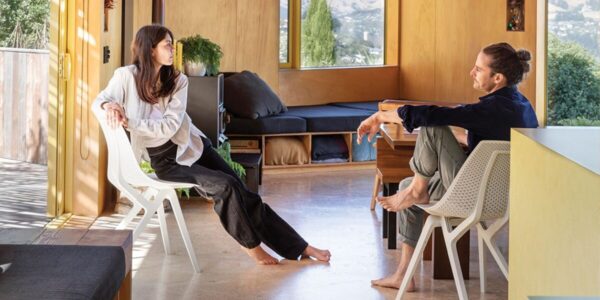
Front and back makeover
Dining alfresco on the coast usually calls for jackets to stave off the chilly air, especially on shaded patios. That’s why John and Libby Alexander located an outdoor dining area in their west-facing front yard ― the sunniest part of their Santa Cruz, California, garden ― and turned their backyard into a space for occasional entertaining.
Before the renovation, a wide asphalt driveway and gravel parking area dominated the front yard of the 1960s house; two large oaks obscured the front door.
In the backyard, a decaying wood deck served as the sole outdoor living space, while several of the coast live oaks beyond the deck were unsound and in danger of falling.
Following an extensive house remodel, landscape architect Michael Bliss designed a contemporary landscape that perfectly complements the home’s midcentury modern architecture.
Staggered walls for privacy
The owners’ desire for privacy and the house’s most prominent architectural detail ― multilevel, tilting rooftops ― inspired the front-yard design.
“I wanted to acknowledge the overlapping roof planes in the landscape,” Bliss explains, “so I mimicked their movement with a series of staggered walls.” The 6-foot-tall concrete partitions provide shelter for the dining area and help define the front entry without looking imposing. In addition, the partitions create generous planting pockets for burgundy and green foliage plants.
Bliss carried out the staggered theme on the ground as well, designing four connecting, offset terraces that lead to the front door. Blue moor grass ( Sesleria caerulea) grows between the cracks. Gardening under oaks
The backyard borders a creek shaded by oaks and other native trees, so Bliss kept the design simple and naturalistic. To provide a seamless connection between indoors and out, he built the rear patio at the same level as the interior floor, using square-cut flagstone pavers to create a geometric design that plays off the home’s clean architectural style.
Beyond the patio, the garden transitions from square steppingstones through a sea of gravel to oak woodland. Since several oaks border the formal garden, Bliss integrated the trees into the overall design, surrounding them with a giant chain fern as well as unthirsty natives such as manzanita and ceanothus.
Both the front-yard dining area and the large back patio are now well-used extensions of the house. “Adding outdoor rooms is equivalent to increasing the square footage of your home,” says Bliss.
What makes it work
To complete the garden and make it truly livable, Michael Bliss added special finishing touches.
Outdoor kitchen: A stainless steel barbecue surrounded by granite countertops, a cafe table, and a heat lamp for chilly nights increases the outdoor dining room’s livability. A new door connects the interior kitchen to the exterior dining area.
Herb garden: Chives, marjoram, oregano, and thyme grow in a sunny spot right outside the kitchen and adjacent to the dining patio.
Lighting: Bliss used accent lights to add drama to the garden. He placed uplighting beneath the oaks and a Japanese maple, and downlighting above the New Zealand flax.
Wall caps: Stonelike wall caps from Napa Valley Cast Stone give the front walls a refined look.
Design: Michael Bliss, Pacific Grove, CA (michael@bernardtrainor.com)
